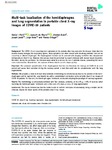| dc.contributor.author | Iglesias Morís, Daniel | |
| dc.contributor.author | Moura, Joaquim de | |
| dc.contributor.author | Aslani, Shahab | |
| dc.contributor.author | Jacob, Joseph | |
| dc.contributor.author | Novo Buján, Jorge | |
| dc.contributor.author | Ortega Hortas, Marcos | |
| dc.date.accessioned | 2024-04-17T09:35:46Z | |
| dc.date.available | 2024-04-17T09:35:46Z | |
| dc.date.issued | 2024-02-01 | |
| dc.identifier.citation | Morís DI, de Moura J, Aslani S, Jacob J, Novo J, Ortega M. Multi-task localization of the hemidiaphragms and lung segmentation in portable chest X-ray images of COVID-19 patients. DIGITAL HEALTH. 2024;10. doi:10.1177/20552076231225853 | es_ES |
| dc.identifier.issn | 2055-2076 | |
| dc.identifier.issn | 2055-2076 | |
| dc.identifier.uri | http://hdl.handle.net/2183/36235 | |
| dc.description.abstract | [Absctract]: Background: The COVID-19 can cause long-term symptoms in the patients after they overcome the disease. Given that this disease mainly damages the respiratory system, these symptoms are often related with breathing problems that can be caused by an affected diaphragm. The diaphragmatic function can be assessed with imaging modalities like computerized tomography or chest X-ray. However, this process must be performed by expert clinicians with manual visual inspection. Moreover, during the pandemic, the clinicians were asked to prioritize the use of portable devices, preventing the risk of cross-contamination. Nevertheless, the captures of these devices are of a lower quality.
Objectives: The automatic quantification of the diaphragmatic function can determine the damage of COVID-19 on each patient and assess their evolution during the recovery period, a task that could also be complemented with the lung segmentation.
Methods: We propose a novel multi-task fully automatic methodology to simultaneously localize the position of the hemidiaphragms and to segment the lung boundaries with a convolutional architecture using portable chest X-ray images of COVID-19 patients. For that aim, the hemidiaphragms’ landmarks are located adapting the paradigm of heatmap regression.
Results: The methodology is exhaustively validated with four analyses, achieving an 82.31% +- 2.78% of accuracy when localizing the hemidiaphragms’ landmarks and a Dice score of 0.9688 +- 0.0012 in lung segmentation.
Conclusions: The results demonstrate that the model is able to perform both tasks simultaneously, being a helpful tool for clinicians despite the lower quality of the portable chest X-ray images. | es_ES |
| dc.description.sponsorship | The author(s) disclosed receipt of the following financial support for the research, authorship, and/or publication of this article: This work was supported by Ministerio de Ciencia e Innovación, Government of Spain through the research project with [grant numbers PID2019-108435RB-I00, TED2021-131201B-I00, and PDC2022-133132-I00]; Consellería de Educación, Universidade, e Formación Profesional, Xunta de Galicia, Grupos de Referencia Competitiva, [grant number ED431C 2020/24], predoctoral grant [grant number ED481A 2021/196]; CITIC, Centro de Investigación de Galicia [grant number ED431G 2019/01], receives financial support from Consellería de Educación, Universidade e Formación Profesional, Xunta de Galicia, through the ERDF (80%) and Secretaría Xeral de Universidades (20%). This research was funded in whole or in part by the Wellcome Trust [209553/Z/17/Z]. For the purpose of open access, the author has applied a CC-BY public copyright licence to any author accepted manuscript version arising from this submission. | es_ES |
| dc.description.sponsorship | Xunta de Galicia; ED431C 2020/24 | es_ES |
| dc.description.sponsorship | Xunta de Galicia; ED431G 2019/01 | es_ES |
| dc.description.sponsorship | Xunta de Galicia; ED481A 2021/196 | es_ES |
| dc.description.sponsorship | Wellcome Trust; 209553/Z/17/Z | es_ES |
| dc.language.iso | eng | es_ES |
| dc.publisher | Sage | es_ES |
| dc.relation | info:eu-repo/grantAgreement/AEI/Plan Estatal de Investigación Científica y Técnica y de Innovación 2017-2020/PID2019-108435RB-I00/ES/CUANTIFICACIÓN Y CARACTERIZACIÓN COMPUTACIONAL DE IMAGEN MULTIMODAL OFTALMOLÓGICA: ESTUDIOS EN ESCLEROSIS MÚLTIPLE | es_ES |
| dc.relation | info:eu-repo/grantAgreement/AEI/Plan Estatal de Investigación Científica y Técnica y de Innovación 2021-2024/TED2021-131201B-I00/ES/DIAGNÓSTICO DIGITAL: TRANSFORMACIÓN DE LA DETECCIÓN DE ENFERMEDADES NEUROVASCULARES Y DEL TRATAMIENTO DE LOS PACIENTES | es_ES |
| dc.relation | info:eu-repo/grantAgreement/AEI/Plan Estatal de Investigación Científica y Técnica y de Innovación 2021-2024/PDC2022-133132-I00/ES/MEJORAS EN EL DIAGNÓSTICO E INVESTIGACIÓN CLÍNICO MEDIANTE TECNOLOGÍAS INTELIGENTES APLICADAS LA IMAGEN OFTALMOLÓGICA | es_ES |
| dc.relation.uri | https://doi.org/10.1177/2055207623122585 | es_ES |
| dc.rights | Atribución 3.0 España | es_ES |
| dc.rights.uri | http://creativecommons.org/licenses/by/3.0/es/ | * |
| dc.subject | COVID-19 | es_ES |
| dc.subject | Chest X-ray | es_ES |
| dc.subject | Heatmap regression | es_ES |
| dc.subject | Lung segmentation | es_ES |
| dc.subject | Hemidiaphragm localization | es_ES |
| dc.title | Multi-task localization of the hemidiaphragms and lung segmentation in portable chest X-ray images of COVID-19 patients | es_ES |
| dc.type | info:eu-repo/semantics/article | es_ES |
| dc.rights.access | info:eu-repo/semantics/openAccess | es_ES |
| UDC.journalTitle | Digital Health | es_ES |
| UDC.volume | 10 | es_ES |






